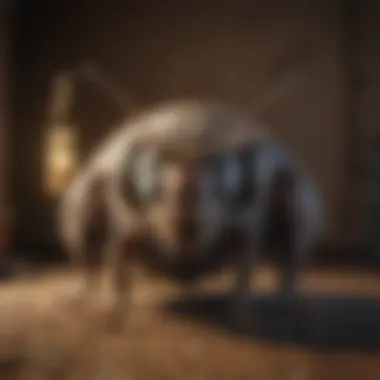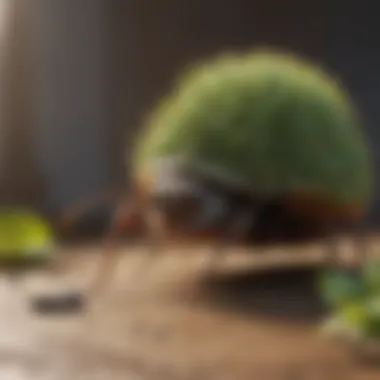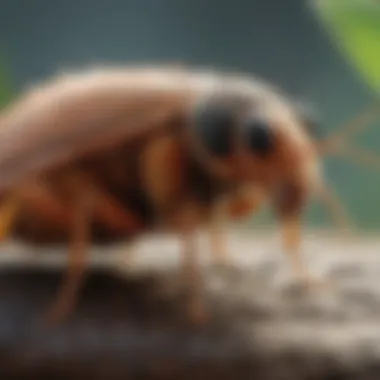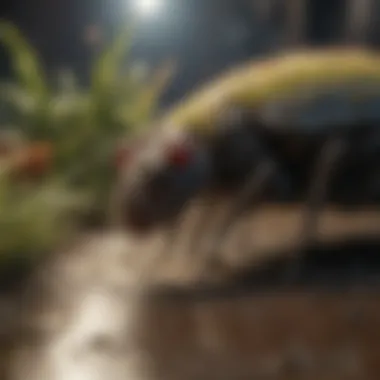Understanding PCT Online Resources for Pest Management


Intro
Pest management is a sophisticated field that requires both theoretical and practical knowledge. Understanding and managing pests effectively involves a multi-faceted approach. The Professional Certified Training (PCT) offers an excellent framework to equip individuals with the knowledge needed. Using online resources, homeowners and gardening enthusiasts can learn various strategies to combat pests through affordable and accessible means. This article details the importance of recognizing pest species, understanding their life cycles, and implementing practical prevention measures.
Understanding the Pest
Identification
Identifying pests accurately is the most critical step in pest management. Some common household pests include ants, roaches, and termites. Each species has unique characteristics that can help in identification. For instance, ants are often seen in trails, while termites prefer damp, secluded areas. Recognizing these signs is essential. One can utilize online platforms that provide robust databases of pest species, guiding users to identify their specific pest problems swiftly.
Life Cycle
Knowing the life cycle of pests is just as vital as identification. Each type of pest undergoes a specific life cycle that includes eggs, larvae, pupae, and adults. For example, the life cycle of a common housefly might last about two weeks, while a German cockroach can take over 100 days from egg to adult. Understanding these stages helps in planning an effective management strategy. Online resources often include interactive timelines and visual aids that simplify the learning process.
Pest Prevention Strategies
Environment Modification
Preventing pests from entering your home involves modifying the environment. Simple actions, such as sealing cracks, reducing clutter, and managing waste, can drastically reduce the chances of infestations. PCT online resources provide detailed guides on how to assess and modify your surroundings effectively. These guides often contain checklists and assessment tools to help you identify potential entry points.
Physical Barriers
Implementing physical barriers is another practical strategy. Methods like installing door sweeps, window screens, and traps can deter pests from accessing your home. The PCT offers instructional videos and diagrams illustrating how to set up these barriers properly. Using such resources can empower individuals to take direct action against pests, ensuring a proactive approach to pest management.
Control Methods
Chemical Control
Chemical control remains a staple in pest management. Pesticides can effectively target specific pests but require careful application to minimize environmental impact. The PCT includes training modules on safely handling and applying chemicals. Users learn about product safety ratings and environmental considerations, making informed choices easier. It's crucial to choose the right products based on the pest's biology and behavior.
Biological Control
Biological control methods are emerging as eco-friendly alternatives. Utilizing natural predators, such as ladybugs for aphid control, can significantly reduce pest populations without chemicals. Online training resources in PCT frequently explore various biological agents, providing tips on how to introduce these organisms into your ecosystem. This approach aligns well with sustainable gardening practices and supports long-term pest management success.
"Integrating technology with pest management provides innovative solutions tailored for modern challenges, empowering individuals and professionals alike."
Foreword to PCT in Pest Management
The realm of pest management has evolved considerably over the years. With the growing complexity of pest issues, the need for advanced training methods becomes evident. Professional Certified Training, commonly referred to as PCT, is an essential aspect of pest management, focusing on equipping professionals with the necessary skills and knowledge. This article aims to explore this concept comprehensively. Remote learning and online resources play a pivotal role in ensuring that pest control professionals stay updated with the latest techniques and insights.
Defining PCT Online
PCT Online refers to the training modules and courses available via digital platforms. These resources offer flexible, self-paced learning opportunities for pest controllers. Enrolling in PCT Online programs is becoming more popular due to the myriad of benefits they provide.
Key features of PCT Online include:
- Convenience: Available at any time allows professionals to learn at their own pace.
- Specialized Courses: Courses cover various topics relevant to pest management, such as pest biology, chemical application, and eco-friendly solutions.
- Continuous Updates: Online platforms can quickly update their materials to reflect the latest research and regulations, ensuring that participants receive the most current information.
This adaptability is crucial in a field that must respond rapidly to emerging challenges and changing regulations.
Importance of Training for Pest Control Professionals
Training is a fundamental component of effective pest management. For pest control professionals, ongoing education through PCT is invaluable. It ensures not only personal career growth but also enhances the capability of the pest control industry as a whole.


Some significant reasons for prioritizing pest control training include:
- Skill Development: Training equips professionals with advanced skills, making them more efficient in identifying and managing pest issues.
- Safety Protocols: Understanding safety measures when handling chemicals or pests minimizes risks to both the professionals and the public.
- Regulatory Compliance: Training helps ensure adherence to state or local regulations, reducing liability issues for pest control companies.
- Customer Confidence: Well-trained professionals instill confidence in clients, leading to better customer satisfaction and repeat business.
In essence, the importance of training cannot be understated in maintaining standards of practice within the pest management field.
"Ongoing training and certification not only boost professional competence but also elevate the entire industry through enhanced service quality."
By focusing on these elements, it becomes clear that introducing PCT in pest management is a strategic move toward creating a more skilled and informed workforce, adaptable to a range of pest-related challenges.
Benefits of Online PCT Resources
The advantages of using online resources for Professional Certified Training (PCT) in pest management are significant. As the landscape of pest control evolves, it is crucial to adapt to new methodologies and tools. Online PCT resources not only enhance the learning experience but also play a pivotal role in improving the effectiveness of pest control strategies. Understanding these benefits helps professionals and homeowners alike navigate pest management more effectively.
Accessibility and Flexibility
Accessibility is one of the cornerstone benefits of online PCT resources. Participants can access training materials at any time and from anywhere, which is especially valuable for busy homeowners and pest control professionals. This flexibility allows individuals to learn at their own pace, reinforcing understanding while accommodating their schedules.
Online platforms break geographical barriers, enabling participation from various locations without the need to travel. For example, a homeowner can learn about pest biology and management techniques without leaving their home. Such access translates to a wider reach of pest control knowledge, promoting effective pest management practices across different communities.
Cost-Effectiveness of Online Training
Investing in pest management training through traditional means can accumulate substantial costs. Online training presents a more economical alternative. Candidates often save on travel expenses, accommodation, and materials, making learning about pest control more accessible. Furthermore, many online courses offer free resources or affordable options, ensuring that even those with limited budgets can participate.
The ability to revisit training materials at any time further adds value. If a specific pest issue arises, homeowners can quickly review relevant content, applying their knowledge effectively. Cost-effectiveness transforms how pest management education is consumed and integrated into everyday life.
Standardization of Knowledge
Standardization is vital in pest management training. Online PCT resources ensure that every participant receives uniform training, minimizing the discrepancies that can arise from varied teaching methods. Consistent information is essential for developing a baseline understanding of pest control principles.
Such standardization can elevate the overall quality of pest management. As homeowners and professionals acquire the same foundational knowledge, they can engage in more meaningful discussions and collaborations. This shared understanding is instrumental in fostering a sense of community, where best practices are exchanged and improvements in pest management are collectively achieved.
"Only with standardized knowledge can we hope to develop effective and sustainable pest management strategies across the board."
In summary, the importance of online PCT resources cannot be overstated. They provide accessibility, cost savings, and a standardized approach to pest management training. Understanding these benefits equips individuals with the necessary tools to address pest issues effectively, promoting healthier environments for all.
Pest Biology and Behavior
Understanding pest biology and behavior is essential for effective pest management. This knowledge informs how pests interact with their environment and their lifecycle stages, which can significantly influence control methods. By comprehending these factors, pest control professionals and homeowners can make informed decisions that lead to better outcomes in pest management. The focus on pest biology also contributes to the development of targeted strategies, minimizing the reliance on blanket approaches that may harm non-target organisms.
Understanding Common Pests
Different types of pests present unique challenges in pest management. Common household pests include ants, cockroaches, bed bugs, rodents, and termites. Each of these pests has distinct biological characteristics that dictate how they behave and how they respond to treatments.
- Ants: They communicate using pheromones and can form large colonies. Understanding their trails can help locate nests and effectively apply control measures.
- Cockroaches: They thrive in humid conditions and can reproduce quickly. Addressing moisture issues in the home can reduce their population.
- Bed Bugs: Their behavior is tightly linked to human activity as they feed on blood while people sleep. Early detection and targeted treatment are crucial.
- Rodents: They are nocturnal and often avoid detection. Baiting in places they frequent is essential for control.
- Termites: They damage wood structures, making prompt identification and intervention important.
Understanding how these pests function allows pest controllers to tailor their strategies effectively.
Behavior Patterns of Insects
Insect behavior is complex, influenced by factors like environmental conditions and biological rhythms. Several patterns emerge that help identify effective management techniques.
- Foraging Behavior: Many pests, such as ants and cockroaches, exhibit foraging behaviors that can be tracked. Knowing when and where they look for food can help in developing baiting strategies.
- Reproductive Behavior: Understanding mating habits can pinpoint when infestations may peak, guiding the timing of control measures.
- Seasonal Activity: Many pest populations fluctuate with the seasons. Warm weather often brings an uptick in activity. Being aware of these cycles can help in the timely application of preventative measures.
- Nest Behavior: Pests like wasps and termites exhibit specific nesting interactions. Disruption of a nest can demoralize and destabilize their populations, achieving control more effectively.


By observing and understanding these patterns, pest management efforts can be optimized for success. The link between pest biology and behavior is essential for designing effective, eco-conscious pest management strategies, ensuring minimal impact on the surrounding environment while maximizing the efficacy of treatments.
"Knowledge is power in pest management. Understanding the biology and behavior of pests ensures that you can address infestations efficiently and effectively."
The integration of this knowledge into practical applications enhances the effectiveness of pest management practices, making it essential for both professionals and homeowners alike to prioritize education and ongoing training.
Effective Pest Control Techniques
Effective pest control techniques are pivotal in both residential settings and professional pest management. Understanding these methods not only helps in controlling pest populations but also in maintaining the overall health of the environment. These techniques combine various elements, such as understanding pest biology, utilizing the right strategies, and employing suitable technologies. By recognizing the importance of these methods, homeowners and pest control professionals can create sustainable pest management plans that are both efficient and eco-conscious.
Integrated Pest Management Strategies
Integrated Pest Management (IPM) is a multifaceted approach to pest control that combines biological, cultural, physical, and chemical tools in a way that minimizes economic, health, and environmental risks. This strategy emphasizes monitoring and identifying pests before determining the best methods for control.
- Monitoring involves regularly inspecting areas prone to infestations.
- Cultural practices include crop rotation, maintaining cleanliness, and ensuring that moisture levels are kept in check.
- Biological controls use natural predators to manage pest populations.
- Physical methods may involve barriers, traps, or exclusion techniques to keep pests from entering spaces.
- Chemical controls use pesticides only when necessary and in targeted ways to reduce impact on beneficial organisms.
IPM prioritizes long-term prevention and solutions that are less disruptive to the ecosystem. This approach aligns well with the core principles of Professional Certified Training (PCT), equipping pest management professionals with the knowledge necessary to implement these strategies effectively.
Chemical Versus Natural Solutions
When it comes to pest control, choosing between chemical solutions and natural alternatives is a significant consideration. While chemical solutions, such as synthetic pesticides, can effectively manage pest populations, they often come with risks to human health and environmental impact.
- Chemical Solutions:
- Natural Solutions:
- Quick acting and potentially more effective for large infestations.
- Require careful application to minimize harm to non-target species.
- Some can lead to resistance in pest populations over time.
- Include biological pesticides, essential oils, and other organic methods that tend to be safer for people and pets.
- Often require a longer time to see results but are gentler on the environment.
- Can promote biodiversity by not harming beneficial insects.
Homeowners should evaluate their specific situations, considering the severity of pest issues and potential impacts of their choices. PCT resources provide guidance on both categories, which helps to make informed decisions.
Advancements in Pest Control Technologies
Technological advancements have transformed pest control methods, making them more effective and user-friendly. Innovations such as smart traps and sensors play a crucial role in managing pests more efficiently.
- Smart Traps: These devices can monitor pest activity and alert users to infestations, improving response time.
- Biological Controls: Continuous research into beneficial organisms offers new opportunities to tackle pests more sustainably.
- Data Analytics: Using data to analyze pest patterns can help in predicting outbreaks and enhancing control measures.
As these technologies evolve, pest control becomes more precise, reducing the need for broader pesticide applications. Professional Certified Training equips pest control professionals with the knowledge to use these technologies effectively. This results in improved pest management practices that are both effective and environmentally responsible.
Incorporating advanced technology into pest control strategies enhances effectiveness and reduces risks associated with traditional methods.
Eco-Conscious Pest Control Practices
Eco-conscious pest control is an increasingly crucial area of study for both homeowners and pest management professionals. This approach emphasizes the need to minimize environmental impact while effectively addressing pest issues. The relevance of eco-conscious practices cannot be overstated. As public awareness and concern for environmental health grow, pest control strategies must adapt accordingly. Understanding the principles behind eco-friendly pest management is essential for integrating these practices into everyday life.
One significant element of eco-conscious pest control is the reliance on beneficial insects. These insects serve as natural predators to many common pests. By nurturing an environment where beneficial insects thrive, homeowners can effectively reduce pest populations without resorting to chemical pesticides. This approach fosters a balanced ecosystem, promoting both plant health and biodiversity. The use of beneficial insects not only controls pests but also enhances the overall quality of the environment.
Role of Beneficial Insects
Beneficial insects play a vital role in maintaining ecological balance. Ladybugs, lacewings, and parasitic wasps are notable examples of beneficial insects. They can effectively manage pests like aphids, caterpillars, and spider mites. Introducing these insects into gardens or landscapes serves multiple purposes:
- Natural pest control: They actively hunt and feed on harmful pest species.
- Pollination: Many beneficial insects, such as bees, contribute to the pollination of plants.
- Soil health: Certain insects, like beetles, help aerate the soil and enhance nutrient cycling.
To attract beneficial insects, homeowners can plant various flowers that provide food sources and habitat. For instance, marigolds, dill, and yarrow are excellent choices. An eco-conscious approach encourages methods that enhance beneficial insect populations rather than eliminate them.


Sustainable Practices for Homeowners
Homeowners can adopt several sustainable practices that are both practical and effective in pest management. These strategies aim to create an environment that naturally wards off pests while being friendly to the ecosystem:
- Maintain healthy soil: Healthy soil fosters strong plants that can resist pest attacks. Regular composting and mulching will improve soil fertility and structure.
- Use native plants: Incorporating native plants in gardens supports local wildlife and creates a balanced ecosystem.
- Water management: Proper watering techniques, such as drip irrigation, reduce water waste and prevent conditions that favor pest development.
- Mechanical controls: Simple tools like traps or barriers can physically deter pests in non-toxic ways.
It is essential to recognize that every spirit of sustainability counts. By opting for eco-conscious pest control practices, homeowners contribute to the broader goal of environmental stewardship.
"Embracing eco-conscious methods can lead to a healthier living environment, reducing dependence on chemicals and promoting biodiversity."
As society continues to grapple with the challenges posed by pests and environmental degradation, adopting these practices is vital. The integration of beneficial insects and sustainable homeowner practices can create harmonious living spaces that support both human and ecological health.
Engagement and Community in Pest Management
Engagement and community involvement in pest management plays a crucial role in achieving effective results. In an era where pest-related issues are becoming more frequent, the significance of collaboration among homeowners, pest control professionals, and enthusiasts cannot be overstated. Understanding the nuances of pest management through engagement helps in sharing both knowledge and practical strategies that can lead to more sustainable practices and solutions.
A supportive community enables members to share experiences. This shared knowledge can help identify pest issues early, promote awareness of pest types, and highlight best control practices. Furthermore, it fosters a collective approach to problem-solving, allowing individuals to work together for common goals.
Sharing Strategies and Experiences
The sharing of strategies and experiences is fundamental in pest management. Participants in the community can exchange what has worked for them and what has not. This open communication is essential in creating a dynamic learning environment.
Through community forums or social media platforms like Reddit and Facebook, homeowners can ask questions and share insights. These interactions lead to the development of effective pest management techniques tailored to specific environments. Some benefits of this sharing include:
- Increased awareness: Learning from others helps individuals recognize pest patterns.
- Diverse strategies: Access to multiple approaches to pest management facilitates better decision-making.
- Support network: Individuals can receive encouragement and advice from peers facing similar challenges.
Moreover, when individuals document their pest-related challenges and solutions, they contribute to a communal knowledge base that can aid future generations in making informed decisions about pest control.
Building a Knowledge Base through Community Interaction
Building a knowledge base through community interaction is another significant aspect of effective pest management. The collective insights from various homeowners and professionals add depth to understanding pest behavior and biology. Engaging in community discussions, attending online workshops, or participating in local gardening clubs can enhance individuals' skills and knowledge.
Consider the following points when interacting within the community:
- Stay informed: Regularly check forums or platforms for updates on pest management trends.
- Contribute actively: Share your own experiences, as every contribution aids the community.
- Seek professional advice: While community advice is invaluable, consulting with certified pest control professionals when needed ensures you have accurate guidance.
By enriching the community's knowledge base, all members can benefit from improved pest management practices.
"Collective efforts in learning will create an empowered community that can prevent and manage pest issues more effectively."
Engagement and community interaction offer pathways to build awareness, share resources, and develop effective pest management techniques. As more individuals in the community actively participate, a significant impact on pest control practices can be achieved.
Finale and Future Directions
Understanding the dynamics of pest management requires an integration of professional knowledge, community interaction, and technological advancements. This conclusion section aims to connect the dots by discussing the significance of these elements and their impact on the future of pest control strategies.
As we navigate a world that increasingly values sustainability and efficiency, pest management practices must evolve accordingly. Homeowners, gardeners, and professionals need to adapt to new methods and approaches. Digital resources provide a vital foundation for this integration. When properly utilized, these resources facilitate continuous learning and adaptation to ongoing changes in pest behavior and biology.
Embracing Technology in Pest Control
The role of technology in pest management cannot be overstated. The advent of online Professional Certified Training (PCT) programs has transformed how pest control professionals acquire their knowledge and skills. Technology enables instant access to vast reservoirs of information about pests and control methods, making learning more dynamic. With the introduction of online platforms, training becomes accessible from anywhere, allowing for scalability and convenience.
Through online courses, practitioners can learn at their own pace, ensuring better retention of information. The utilization of data analytics also allows for the tracking of pest populations in real-time. This data-driven approach enables pest control technicians to make informed decisions based on evidence rather than assumptions. Furthermore, remote monitoring technologies enhance the proactive capabilities of pest controllers, leading to more precise interventions.
In summary, embracing technology in pest control not only streamlines training but also enhances overall effectiveness in pest management strategies. It represents a forward-thinking approach that is essential given the ever-changing landscape of pest behavior and environmental factors.
The Evolving Landscape of Pest Management
Today's pest management landscape is shaped by numerous factors, including climate change, urbanization, and advancements in genetic science. These factors contribute to the emergence of new pest species and the changing behaviors of existing ones. It is crucial to remain informed about these developments to adapt pest management practices accordingly.
Particularly, professional training programs must regularly update their curriculum to reflect these changes. The challenges posed by new pests require up-to-date knowledge and techniques. As the field progresses, traditional methods must coexist with innovative practices like integrated pest management and biological control. This is not just a trend but a necessity for sustainable pest control.







